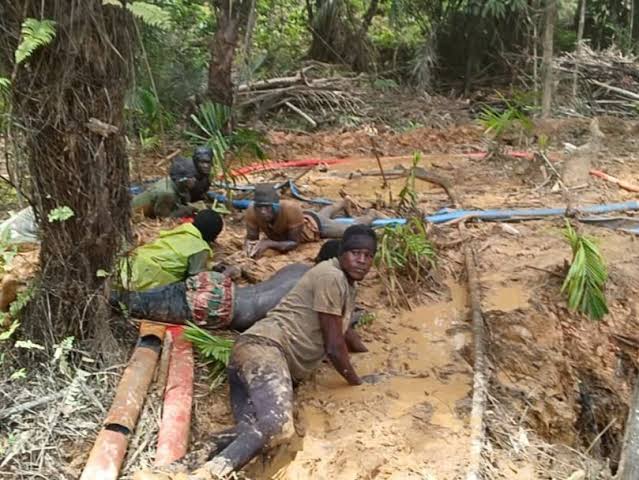Ghana’s struggle with illegal mining has entered a new and more dangerous phase. What began as small-scale, makeshift operations has expanded into networks of armed groups, fortified enclaves and criminal economies that challenge the authority of the state itself.
A new national security assessment by Major Dr Ebenezer Kwakye Agyemang (Rtd) warns that many galamsey zones have evolved into “gangster communities” — areas where armed actors, not the Republic, dictate the rules.
Major Agyemang’s report for the Crossbridge Leadership Institute argues that Ghana is confronting something far more complex than environmental degradation or regulatory failure.
Illegal mining is now intertwined with organised crime, political complicity and the widespread circulation of unregistered weapons. In several communities, the state has lost meaningful control as armed groups establish their own systems of order, taxation and enforcement.
“These are not ordinary mining sites. They are emerging criminal microstates,” Major Agyemang writes.
The transformation did not happen overnight. For years, galamsey thrived on the margins — in remote forests, riverbanks and abandoned concessions.
But the economic incentives were enormous. Poverty, joblessness, porous borders, weak land governance and corruption created fertile ground for expansion.
Over time, illegal miners moved from shovels to excavators, from torchlights to sophisticated drilling equipment, and from unarmed youth to groups with access to pump-action guns, pistols and explosives.
The moment weapons became common, the balance of power shifted decisively. Gangs began controlling access to mining sites. Levies were imposed on miners, transporters and traders.
Local authorities were threatened into silence. Police posts, often under-resourced, became spectators. The report describes this as “parallel governance,” a scenario in which the authority wielded by criminal actors outstrips that of the state.
Several areas across the Ashanti, Western, Ahafo, Central and Savannah regions have become entrenched strongholds. These enclaves are more than temporary camps. They are fully developed settlements with thousands of residents.
One of the best-known examples — “Jerusalem in the Forest” — resembles a sprawling mining city complete with brothels tied to trafficking syndicates, drug markets and an armed militia known as the Bulldogs.
These groups enforce their own rules, police their own territories and determine who enters or leaves. Major Agyemang notes that their confidence suggests they believe they “operate beyond the reach of the state.” This perception is reinforced each time a state agency is attacked or overpowered.
Such confrontations have grown increasingly frequent. Taskforces from the Forestry Commission, EPA, and the National Anti-Illegal Mining Operations Secretariat (NAIMOS) have been ambushed, chased out of mining areas, or blocked by hostile crowds.
In one case, a NAIMOS team that had arrested two alleged kingpins in Ahafo was surrounded by hundreds of armed residents demanding their release. Security forces had to be deployed to extract the team safely.
The report warns that Ghana has more than a million unregistered firearms in circulation, many concentrated in mining regions. Locally manufactured guns, smuggled pistols and stolen explosives are all part of the arsenal.
The porousness of borders and weak stockpile management have enabled the steady flow of arms.
Some explosives from Ghana have reportedly ended up with insurgent groups in Mali and Guinea, indicating a two-way trade that links the galamsey economy to broader regional insecurity, the report says.
With weapons now so accessible, the risk of violent escalation in mining communities is significantly higher than in previous decades. Disputes over pits, gold sales, levies or rival factions can quickly turn fatal. The presence of foreign fighters from neighbouring countries further raises the stakes.
What the report makes clear is that galamsey can no longer be viewed as a simple illegal livelihood. It now resembles a layered criminal architecture with financiers, lookouts, political patrons and regional networks. Some enclaves operate informal courts. Others run extortion and money-laundering schemes through mobile money.
The level of coordination, secrecy and violence aligns more with transnational organised crime than artisanal mining.
Major Agyemang warns that Ghana is witnessing “the early stages of alternate governments.” These groups enforce their own laws, collect their own revenues and dispense their own versions of justice.
In areas where trust in traditional authorities and state institutions has eroded, residents often turn to gang leaders for protection and economic opportunities — even when that protection is rooted in fear.
The consequences for ordinary people are devastating. Families live under constant intimidation. Young people are drawn into mining gangs, where they are exposed to drugs, exploitation and violence. Schools lose students to mining pits. Women, often financially dependent on male miners, become vulnerable to coercion and abuse.
The breakdown of local governance is stark. District assemblies, traditional councils and community policing units no longer have influence in some areas. As the report puts it, the social fabric is “shredded,” replaced by systems of survival rather than development.
Perhaps the most sobering part of the report is the comparison to other regions where unchecked criminal economies evolved into armed insurgencies.
The author notes parallels with the Niger Delta militancy, Brazilian gang territories and the rise of extremist groups in the Sahel. These movements often start with economic grievances and weak state presence — conditions that now mirror parts of Ghana’s mining zones.
Major Agyemang describes the situation as “a dangerous cocktail.” Weapons, criminal financing, political interference and territorial control together form a platform from which violent extremism can grow.
The report calls for a multi-dimensional response — not just military operations, but targeted prosecutions, community policing, political accountability and strong, visible state presence in affected areas. It emphasises that ad hoc raids cannot dismantle entrenched criminal economies.
Only sustained, coordinated and intelligence-led action can reverse the current trajectory.
Above all, Major gyemang stresses urgency. “Ghana cannot afford to sit back any longer,” he writes.
Each day of inaction allows the criminal networks to deepen their roots, expand their revenue streams and consolidate their power.






